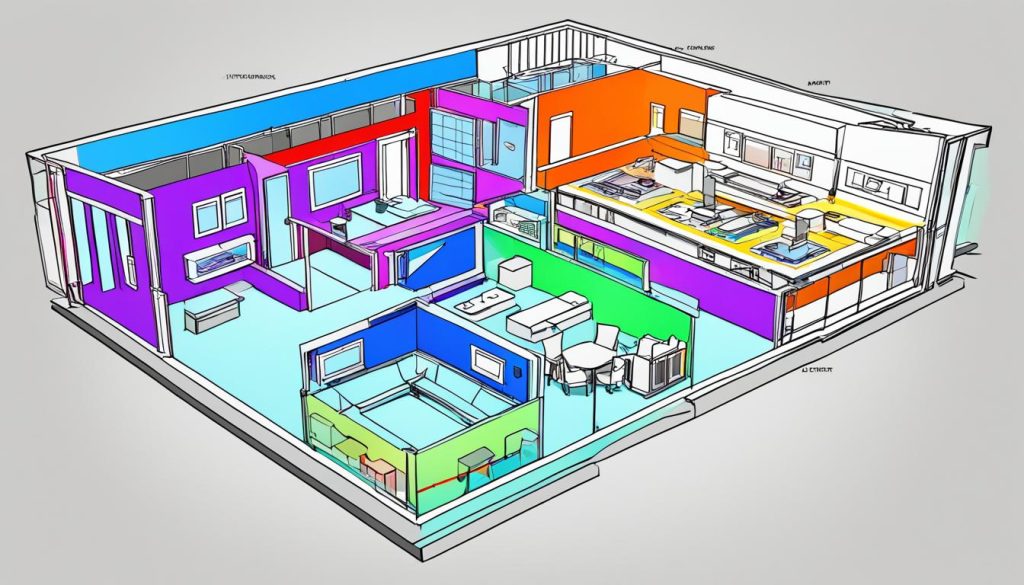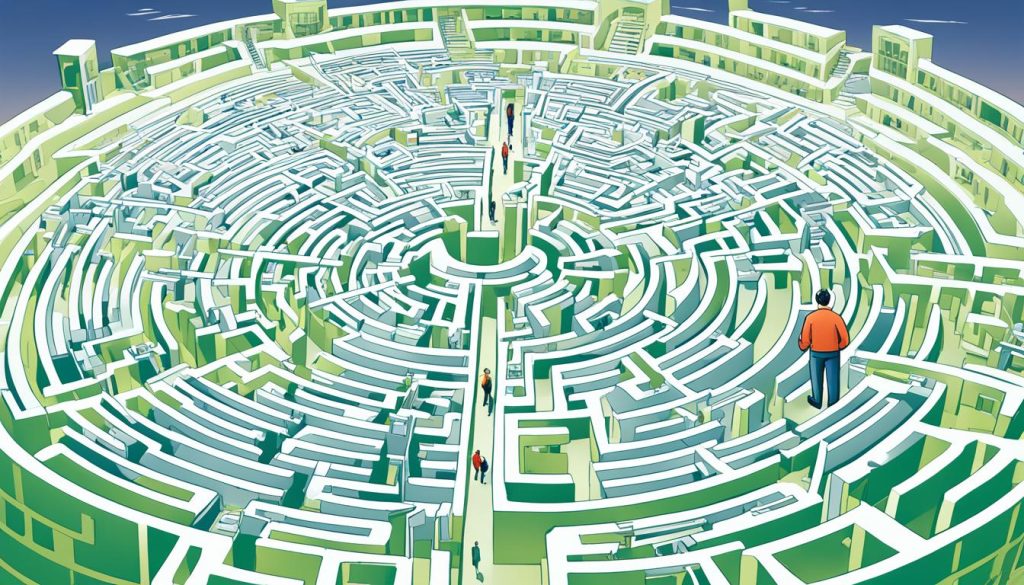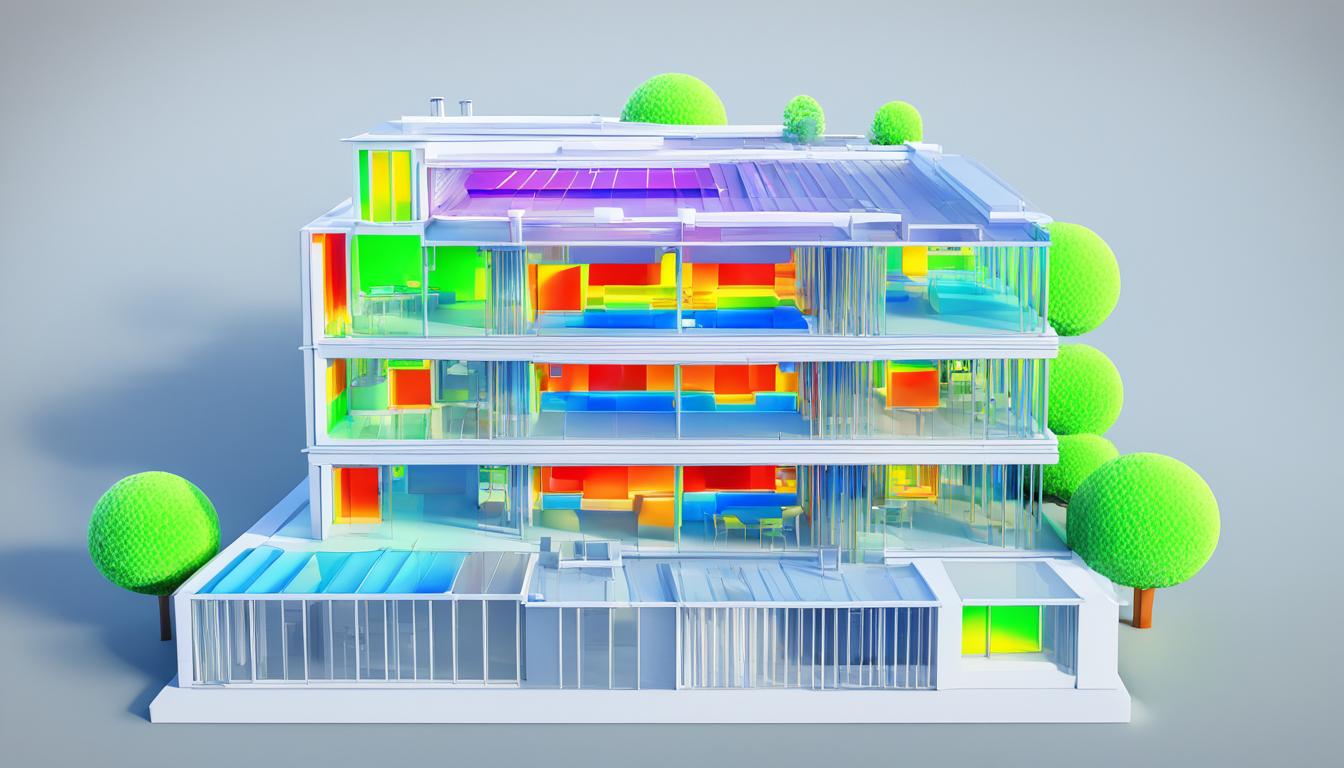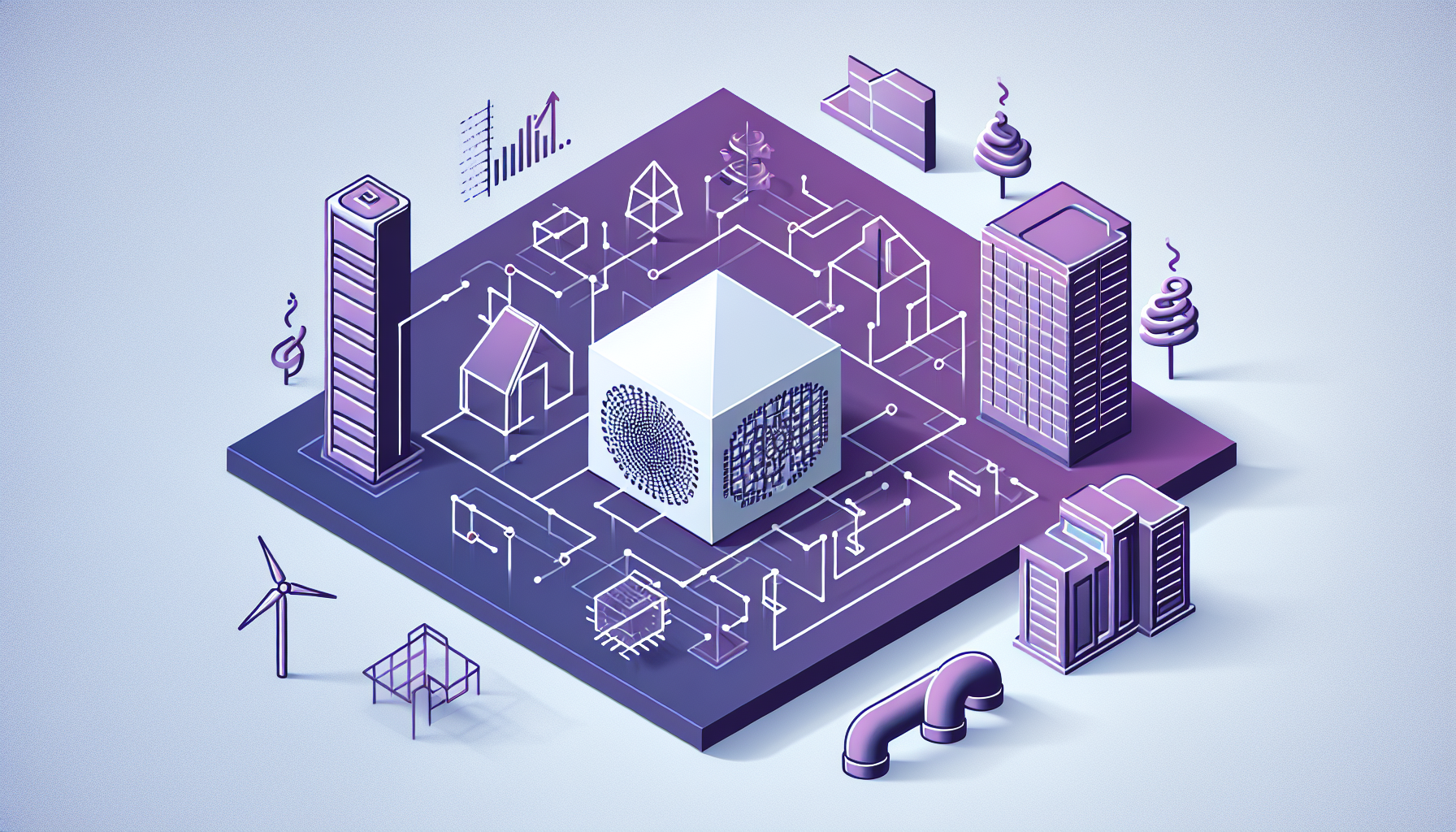Thermal comfort modeling is a key tool for boosting occupant satisfaction in HVAC design. It looks at many factors that affect the indoor environment. This helps create ventilation systems that meet the unique needs of different buildings.
This method considers air temperature, air movement, radiant heat, and humidity levels. By focusing on these, you can make HVAC systems that keep most people comfortable.
The Health and Safety Executive says that 80% of people should feel happy with the temperature inside. Using thermal comfort modeling in your HVAC design helps you aim for this goal. It can make people more satisfied with their indoor space.
Understanding Thermal Comfort in Buildings
Thermal comfort is key to how we feel in indoor spaces. It’s not just about the temperature. It includes many factors that affect how satisfied people are. Let’s look into what thermal comfort means and how it affects building occupants.
Definition of Thermal Comfort
Thermal comfort means feeling okay with the temperature around you. It’s a feeling that changes from person to person. When you’re comfortable, you’re not too hot or too cold. You just feel right.
Importance of Thermal Comfort for Occupant Satisfaction
Feeling comfortable is linked to being happy with your surroundings. When you’re comfy, you work better, stay focused, and feel good. But, being uncomfortable can make you less productive and even sick.
Factors Influencing Thermal Comfort
Many things affect how comfortable you feel inside:
- Air temperature
- Relative humidity
- Air velocity
- Radiant temperature
- Personal factors (clothing insulation, activity level)
Knowing these factors helps create better indoor spaces. By thinking about all these, you can make HVAC systems that really meet people’s needs. This makes buildings more comfortable for everyone.
The Role of HVAC Systems in Thermal Comfort
HVAC systems are key to keeping buildings comfortable. They manage air temperature, humidity, and movement. This makes a space where people can work well and feel good.
When designing your HVAC, think about these important things:
- Diurnal temperature changes
- How sunlight affects windows
- Different heating needs in various areas
- Bringing in fresh air
- Heat from electronics
- Insulation in walls
- How outside affects windows and doors
Building energy simulation tools are very helpful for thermal comfort. They show how air moves and helps you fine-tune your HVAC. With Computational Fluid Dynamics (CFD) simulations, you can make your system work better and keep people comfortable.
| HVAC Component | Role in Thermal Comfort | Optimization Technique |
|---|---|---|
| Air Conditioning | Temperature Control | Zoning and Smart Thermostats |
| Ventilation | Air Quality and Movement | Demand-Controlled Ventilation |
| Humidification | Moisture Balance | Adaptive Humidity Control |
By using these parts and methods in your HVAC design, you can make your building more comfy and save energy. Remember, thermal comfort is more than just the temperature. It’s about many factors your HVAC system should handle.
Introduction to Thermal Comfort Modeling
Thermal comfort modeling is a new way to design HVAC systems. It focuses on making sure people are happy with their indoor spaces. This method uses special software to predict how people will feel in different places.
What is Thermal Comfort Modeling?
This method uses computer simulations to guess how people will feel in buildings. It looks at things like temperature, humidity, and air movement. It also considers what people are wearing, how active they are, and their personal comfort levels.
Benefits of Using Thermal Comfort Models in HVAC Design
Using thermal comfort models in HVAC design has many benefits:
- Improved occupant satisfaction
- Enhanced energy efficiency
- Reduced operating costs
- Better indoor air quality
By predicting comfort levels early on, designers can make HVAC systems better for both comfort and saving energy.
Types of Thermal Comfort Models
There are different types of thermal comfort models used in HVAC design:
- Predicted Mean Vote (PMV) model: Estimates average thermal sensation on a 7-point scale
- Computational Fluid Dynamics (CFD): Simulates air movement and temperature distribution
- Adaptive comfort models: Account for occupants’ ability to adapt to changing conditions
Each model gives different insights into making indoor spaces comfortable.
Key Parameters in Thermal Comfort Modeling
Thermal comfort modeling looks at how people feel in different places. It uses environmental and personal factors to make predictions. These factors help design better HVAC systems for buildings.
Environmental factors greatly affect how comfortable you are. These include:
- Air temperature
- Air velocity
- Radiant temperature
- Relative humidity
Personal factors are unique to each person. They change how comfortable you feel. The main personal factors are:
- Clothing insulation
- Metabolic rate
Some models also consider more personal details like age, size, weight, and gender. These details help predict comfort levels for different people more accurately.
| Environmental Factors | Personal Factors |
|---|---|
| Air temperature | Clothing insulation |
| Air velocity | Metabolic rate |
| Radiant temperature | Age |
| Relative humidity | Size and weight |
Using these parameters, designers can guess how people will feel in a space. This info helps make HVAC systems that keep people comfy in all kinds of buildings.
Use Thermal Comfort Modeling for HVAC Design
Thermal comfort modeling changes the game in HVAC system design. It makes sure spaces are comfy for people and uses energy wisely. Let’s see how to use this powerful tool in your projects.
Steps to Implement Thermal Comfort Modeling
To use thermal comfort modeling in your HVAC design, follow these steps:
- Define the building’s shape and layout
- Input environmental details like temperature and humidity
- Set up how people will use the space
- Run simulations with thermal modeling software
- Look at the results and tweak the design as needed
Tools and Software for Thermal Comfort Modeling
There are many tools for simulating building energy use:
- EnergyPlus: A detailed tool for energy studies
- DesignBuilder: Easy to use for thermal simulations
- IES Virtual Environment: Combines various building performance checks
- OpenStudio: A free platform for energy modeling
Integrating Modeling Results into HVAC Design
Use the results of thermal comfort modeling to improve your HVAC design:
- Adjust air flow by changing vent sizes and spots
- See how the system works in different areas
- Find a balance between keeping people happy and saving energy
- Do more simulations to get the best results
Adding thermal comfort modeling to your HVAC design makes systems better and more efficient. It puts the focus on making people happy.
Advanced Techniques in Thermal Comfort Modeling
Thermal comfort modeling has grown a lot with new technologies. These new tools help predict temperatures more accurately and create better indoor spaces. Let’s look at some new methods changing HVAC design.

Computational fluid dynamics (CFD) is a big change in thermal comfort analysis. It simulates how air moves and temperatures spread in spaces. With CFD, you can see complex air patterns and spot comfort problems early.
Building information modeling (BIM) takes thermal comfort further. It combines thermal data with building designs and structures. This method helps you fine-tune HVAC systems with other building parts in mind.
Machine learning algorithms are changing how we predict comfort. These smart systems look at lots of data to guess thermal likes. They learn from past actions to set HVAC settings right for the future.
| Technique | Key Benefits | Application Areas |
|---|---|---|
| Computational Fluid Dynamics (CFD) | Detailed airflow analysis, temperature mapping | Large open spaces, atriums, industrial facilities |
| Building Information Modeling (BIM) | Integrated design approach, clash detection | New construction, major renovations |
| Machine Learning Algorithms | Personalized comfort predictions, energy optimization | Smart buildings, office spaces, healthcare facilities |
These new methods together make indoor spaces more comfortable and efficient. Using CFD, BIM, and machine learning, you can design HVAC systems that meet people’s needs and save energy.
Case Studies: Successful Applications of Thermal Comfort Modeling
Thermal comfort modeling has changed how we make buildings better. Let’s look at real examples of how it helps with HVAC systems and saves energy.
Office Building Optimization
A big tech company in Silicon Valley used thermal comfort modeling to change their office HVAC. They cut energy use by 30% and made employees 25% happier. The model looked at solar gain, when people were there, and how much heat devices gave off.
Residential HVAC Improvements
Homeowners in a suburb worked with an HVAC company on thermal comfort modeling. They set up systems that matched their daily lives. This cut energy bills by 20% and ended fights over the thermostat.
Commercial Space Comfort Enhancement
A mall in Florida used thermal comfort modeling to fix uneven temperatures. The study found hot spots near big windows and cold spots near vents. After making changes, people stayed longer, and sales went up.
These examples show how thermal comfort modeling makes a big difference. By looking at each building’s unique needs and how people use it, HVAC systems work better. This makes everyone happier and more comfortable.
Challenges and Limitations of Thermal Comfort Modeling
Thermal comfort modeling has big hurdles in predicting how happy people will be with the temperature. One big challenge is understanding what each person likes. Everyone has their own idea of what feels comfortable, making it hard to make a model that works for everyone.
Another challenge is how people act in different situations. Some might open windows, change the thermostat, or use fans to feel better. These actions are hard to guess and can really mess with how accurate the model is.

Places that are not the same everywhere are tough for models to handle. Think about a room with different spots that are hotter or cooler. It’s hard to get these differences right in a simulation, which can make the model’s predictions not match reality.
Models also get limited by the need to simplify things to be useful. These simplifications help make models easier to work with but can miss some important details about how comfortable a space feels.
| Challenge | Impact on Modeling | Potential Solutions |
|---|---|---|
| Individual Preferences | Reduced accuracy for diverse populations | Personalized comfort profiles |
| Occupant Behavior | Unpredictable changes in thermal conditions | Adaptive models, real-time monitoring |
| Non-uniform Environments | Inaccurate comfort predictions | Advanced CFD simulations |
| Model Simplifications | Limited representation of complex factors | Machine learning enhancements |
To beat these challenges, researchers are working hard to get better at collecting data and making models smarter. By tackling these issues, we can make thermal comfort models more reliable and useful for designing heating and cooling systems.
Future Trends in Thermal Comfort Modeling and HVAC Design
The future of thermal comfort modeling and HVAC design is changing fast. New tech is changing how we control the climate inside buildings. Let’s look at some exciting changes that could change the industry a lot.
Integration with Building Information Modeling (BIM)
BIM is changing how we design HVAC systems. It lets designers make detailed 3D models of buildings and their HVAC setups. By combining thermal comfort modeling with BIM, engineers can check and improve comfort levels early on.
Artificial Intelligence and Machine Learning Applications
AI is becoming more common in HVAC design. Machine learning can guess how people will act and change systems to fit. This smart way uses less energy and makes people more comfortable. AI looks at lots of data to make HVAC systems work better in real time.
Personalized Comfort Solutions
Personalized comfort is the new goal in HVAC design. With advanced sensors and smart devices, systems can learn what each person likes. This means everyone gets their perfect comfort level, making them happier and more productive.
| Trend | Benefits | Challenges |
|---|---|---|
| BIM Integration | Improved design accuracy, better collaboration | High initial costs, training requirements |
| AI in HVAC Design | Energy efficiency, predictive maintenance | Data privacy concerns, complex implementation |
| Personalized Comfort | Increased occupant satisfaction, productivity gains | Balancing individual needs, system complexity |
These new changes aim to make indoor spaces more responsive, efficient, and comfortable. By using these technologies, HVAC designers can give better comfort and use less energy.
Best Practices for Implementing Thermal Comfort Modeling in HVAC Design
To make buildings more comfortable and energy-efficient, follow HVAC design best practices. Start with international thermal comfort standards like ASHRAE 55. These guidelines help create indoor spaces that feel good.
Think about both the environment and the people in your design. Factors like air temperature, humidity, and air speed matter a lot. But don’t overlook the clothes people wear and how active they are. Use simulation tools to predict how comfortable a space will be. This helps you find the right balance between comfort and saving energy.
After you’ve installed your HVAC system, check how it’s doing in real life. Feedback from users is crucial for making your designs better. Keep updating your models with this new information. By doing this, you’ll make HVAC systems that are both comfortable and energy-efficient.





0 Comments